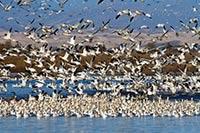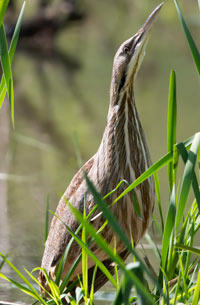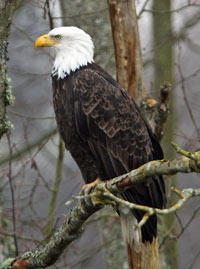Local Birding Sites: Beyond the North Bay
Check back for regular updates and additional site profiles.
Sacramento National Wildlife Refuge
- Tacy Dunham The Sacramento National Wildlife Refuge is located along Interstate 5 north of the city of Sacramento. The trek from the Bay Area is an all day adventure, but it’s worth it. The refuge is seasonal home to over 400,000 snow, Ross’ and white-fronted geese and ducks number about 2 million. Over 300 species of birds have been sighted here. To reach the Sacramento National Wildlife Refuge, take Highway 101 to Highway 37 and turn north onto Highway 80. Then, follow Highway 505 until it merges with Highway 5 and continue 20 miles north of Williams. Exit at Road 68 and turn left. Follow the signs to the Refuge. It’s about a 2.5-hour drive from Marin. The best way to begin a visit to the Sacramento NWR is by stopping at the Visitor Center. It’s open daily November through February from 9 a.m. to 4 p.m. and weekdays only from March through October. Exhibits introduce you to some of the species you’ll see. There are picnic tables, restrooms and free wildlife checklists at the Visitor Center. The Refuge entrance fee is $6 per vehicle. The Refuge’s main feature is a 6-mile self-guided auto tour. There’s also 2 miles of walking trails through varied habitat near the Visitor Center. The 6-mile auto tour provides great birding from your vehicle. Each car functions as a rolling blind. It’s not unusual for ring-necked pheasants or jackrabbits to cross the road unconcerned about cars. Hawks are easy to see, they can’t hide when perching in leafless trees. Look closely, those small silhouettes perched on branches may be American kestrels or loggerhead shrikes. As the car rolls slowly past the large ponds, the geese become the stars of the show. There are so many thousands of geese, they overflow onto islands and up on the land surrounding the ponds. When huge flocks take flight, the sky turns white with churning wings and honking. Ducks are well represented in variety of species and numbers. Northern pintails, northern shovelers and mallards number in the many thousands and there are plenty of gadwalls, ruddy ducks, green-winged teals, cinnamon teals, gadwalls, and buffleheads, too. There may or may not be large numbers of shorebirds. The water levels in the ponds determine their presence. The Park & Stretch Area provides a place to walk up onto a viewing platform over Logan Creek. This riparian habitat is good for viewing songbirds and woodpeckers. Bald eagles are often seen perching in the trees along the creek. On the final section of the drive, the road skirts the edge of marshes. This is a good place to listen and watch for rails and American bittern. This is also an excellent area to sort out sparrows and compare them to American pipits. If you have time, add a visit to the Colusa National Wildlife Refuge. It’s about 10 miles south of the Sacramento NWR. From Interstate 5, exit onto Route 20 just north of Williams. Follow Route 20 a few miles east to the Colusa NWR. This refuge offers a 1-mile walking trail, a 3-mile auto tour and a viewing platform. There’s no entrance fee. This is where the rare falcated duck has been spending its winters for the past couple years. Sightings here can add white-faced ibises, egrets and herons to your checklist and, of course, you’ll see more snow, Ross’ and white-fronted geese. Bring binoculars and your bird identification book. For more information visit the Sacramento National Wildlife Refuge website. WBU staff member Tacy Dunham is the author of two trail guidebooks for Marin County and wrote the Hike of the Week column for the Marin Independent Journal for many years. - Go to our Birding Sites Homepage |
 Snow Geese |
|
American Bittern |
|
|
Ruddy Duck |
|
|
Bald Eagle |




